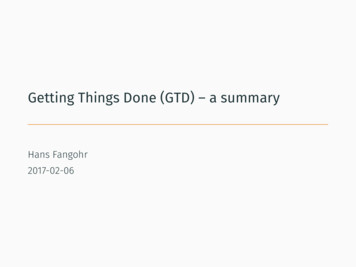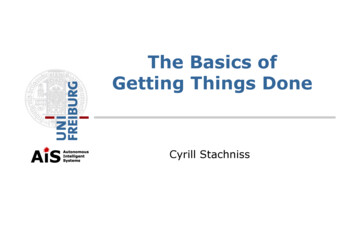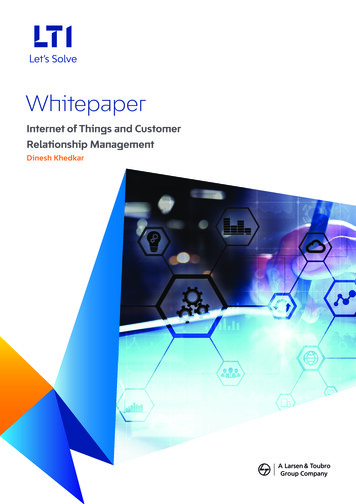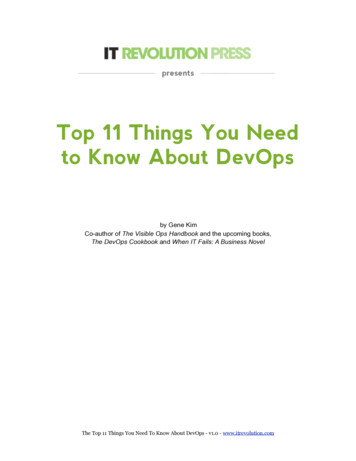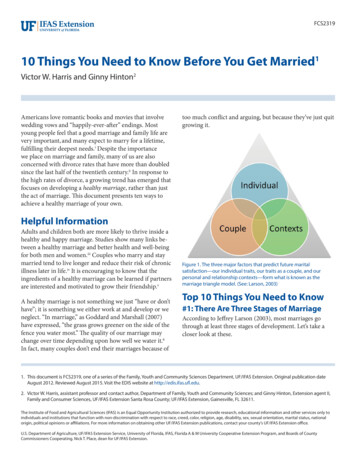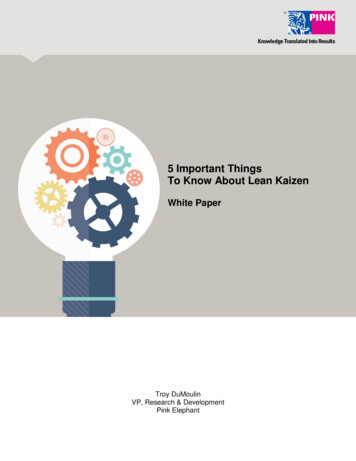
Transcription
5 Important ThingsTo Know About Lean KaizenWhite PaperTroy DuMoulinVP, Research & DevelopmentPink Elephant
5 Important Things To Know About Lean KaizenIntroductionTime has proven again and again that organizations that rest on their laurels, contentwith the status quo, will inevitably find themselves on a slow-but-sure path to obscurity.In fact, the principle of entropy teaches us that the moment we stop inserting newenergy into a system, combined with a healthy dose of discontentment and lack ofcuriosity about our current state, we begin the long, slow slide into irrelevance.This has never been more evident than in our current fast-paced global marketplace.Studies have shown that 96% of businesses fail within ten years of their startup, makingit imperative that companies act today.Organizations need to fight this threat by encouraging and developing a culture focusedon continuous improvement or, in Lean terminology, to establish a learning or “kaizen”mindset.Nowhere is this more important than in the IT value chain. The IT industry is currentlyfacing a growing risk gap where IT shops can’t scale fast enough to close the wideninggap between the rate of business demand and the speed of IT delivery.There are many contributing factors responsible for this gap, including the growingcomplexity of IT delivery models through increased use of third-party suppliers;consumer-driven expectations for on-demand, streaming and instant-on; an evergrowing backlog of work-spawned technological changes; the inability of fragmentedand silo-oriented processes to keep pace and external market drivers that pressure ITto shorten the time to market, lead times, etc.Some of the major challenges being faced by organizations today include: quality,efficacy and cost of IT services. The question is: how can kaizen help optimize ITservice delivery capabilities to be better, faster, and cheaper?This white paper will outline five important things leaders should know about thepractice of Lean Kaizen and how applying a kaizen approach can positively impact yourorganization.pinkelephant.comPage 2
5 Important Things To Know About Lean KaizenThe first step for a problem-solving mindset is to establish a desired state of the serviceor process; secondly, understand the current baseline and gap; and finally, work toincrementally close the gap towards the chosen state by implementing kaizenimprovement steps.The goal of kaizen is to have everyone’s mind focused on improvement all the time.This mindset change will impact the hundreds or thousands of decisions being madewithin an organization at the keyboard level every day. When the implementation ofkaizen is aligned with a common vision, these keyboard decisions can be made moreeffectively.Successfully adopting a kaizen mindset will give organizations a competitive advantageby proactively finding and fixing their own problems.2. There are two types of kaizen: Kaizen Event or Daily KaizenA Kaizen Event, which may also be referred to as Improvement Kaizen, is when aproblem in a process has been identified as needing improvement and a team is pulledtogether from across various work areas or departments for an intense two- orthree-day workshop to resolve the problem.One of the most important factors to consider is selecting an effective leader/facilitatorand the right mix of representatives from across the organization.A Kaizen Event involves bringing in stakeholders involved in a cross-functional processwhere the problem has yet to be defined, improvement requires a cross-functionalapproach and the solution is not readily discernable.A Daily Kaizen is when an individual or small group of people from the same teamcontinuously examine the environment in which they operate and, on a daily basis,identify problems and change dynamics to make it easier for stakeholders in theenvironment to deliver a consistently high-quality service that provides customer valuequickly and efficiently.A Daily Kaizen is best understood as a problem and improvement opportunity that is lowor no cost and is within the purview of an individual or a single team to improve withinthe timeframe of a single day. In this case, a cross-functional team is not required andthe complexity of the improvement opportunity is low. In order to implement kaizen, it isimportant to have the knowledge, skills and methodology to identify, plan and implementincremental service and process improvements. Lean and Six Sigma provide specifictools and improvement techniques to identify, analyze and improve problems.pinkelephant.comPage 4
5 Important Things To Know About Lean KaizenThe essence of using either type of kaizen is that identifying problems and solving theirroot cause drives individual and organizational learning.3. Kaizen is a subset of Lean IT.The central focus of Lean IT is assessing a process to eliminate waste, where waste isdefined as something that adds no value to a product, service or output.The ultimate goal of Lean is to provide perfect value to the customer through a flawlessvalue-creation process that has a target of zero waste. This goal is enabled by kaizen,which is focused on continuous, incremental improvement.Often, in situations where kaizen hasn’t been adopted, an IT worker will work as hard asthey can and technically complete their work to the best of their ability. But, if theyweren’t given the context for their task, the end-product often won’t meet the need forwhich it was intended.One of the tenets of kaizen is to ensure that context is understood and that the systemprovides the conditions in which the work can be successfully completed to align withthe desired outcome.4. A Kaizen Event is inclusive – it isn’t limited to one area or function within anorganization.The challenge we face today is that many current organizational structures,performance management systems, processes and tools are oriented in respect tovertical technology towers.This means many IT leaders look for ways to locally optimize their own processes andtools by department or IT group, but don’t look at optimizing the flow of the enterprisevalue streams. Many organizations may also have separate strategies for eachtechnology tower without considering the full system’s performance.Lean thinking changes the focus of management from optimizing separate technologies,assets and vertical departments to optimizing the flow of products and services throughthe entire value streams that flow horizontally across technologies, assets anddepartments finally reaching the customers.Silo vs. Systems MindsetsThe missing piece in a lot of technology organizations is that individual workers don’tsee the end-to-end system because they are diligently working away in their respectivepinkelephant.comPage 5
5 Important Things To Know About Lean Kaizenfunctional silos. In many instances, the workers don’t deliver the desired level of qualitythe first time – not because they didn’t want to, but because the system they’re workingwithin is so siloed and disjointed that they don’t have the knowledge with which to workdifferently.A task-oriented organizational structure often promotes isolation instead ofcollaboration. Workers are often specialists – a good analogy to demonstrate this ishaving a worker who specializes in producing specifically-designed car bumpers. Whenthe bumper is finished, it is perfect except for the fact that the design of the vehicle wastweaked so now the completed bumper no longer fits but no one had notified thebumper specialist!The implementation of both Lean IT and kaizen should enable organizations to takecontrol of processes and improve the efficiency of any value stream.5. Lean & Kaizen have been embraced by DevOps.Originally created to span the interests of both development and operational teams,DevOps is now a term used to describe the multiple elements that all work collectivelyto increase the quality of IT while also increasing speed and reducing costs.IT organizations are now focusing on optimizing the full IT value chain. DevOps is thesum of Lean, Agile Development and Continuous Delivery models and encompasses alltheir values, principles, practices, teaming models and tools. The kaizen mindset, whichfalls under Lean, is therefore part of the multi-layered, sequenced and interdependentprocesses, frameworks and practices that comprise DevOps.pinkelephant.comPage 6
5 Important Things To Know About Lean KaizenAbout Pink ElephantWe Lead The Way!A premier global training, consulting and conference service provider, Pink Elephanthas an undisputed reputation for leading the way. We’re proud of our pioneering andinnovative spirit, which has enabled us to introduce and spearhead many revolutionaryconcepts and programs since our inception forty years ago.About The AuthorTroy is considered by many to be one of the world’s foremost ITIL and ITSM experts. Apassionate and experienced Executive Consultant, Troy is always willing to use his richand extensive background to share what he knows, and is always on the hunt for moreknowledge. Troy always has his finger on the industry’s pulse – if there’s a questionabout what the latest trends in ITSM, Lean, Business Relationship Management orOrganizational Change Management are, he has the answer! Troy is a frequent speakerat ITSM events, a contributing author for several books focused on ITSM and Lean ITconcepts, and his blog is one of the industry’s most popular and informative.Contact ant.comITIL is a registered trade mark of AXELOS Limited used under permission of AXELOS Limited. All rights reserved.pinkelephant.comPage 7
kaizen is aligned with a common vision, these keyboard decisions can be made more effectively. Successfully adopting a kaizen mindset will give organizations a competitive advantage by proactively finding and fixing their own problems. 2. There are two types of kaizen: Kaizen Event or Daily Kaizen
